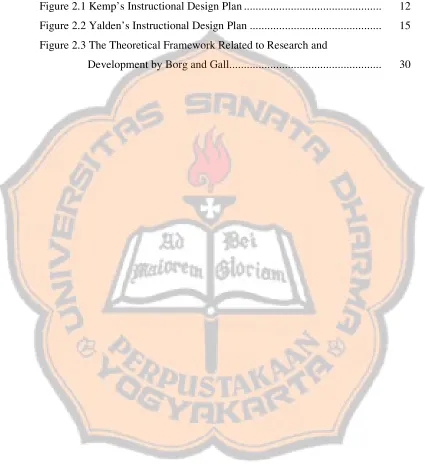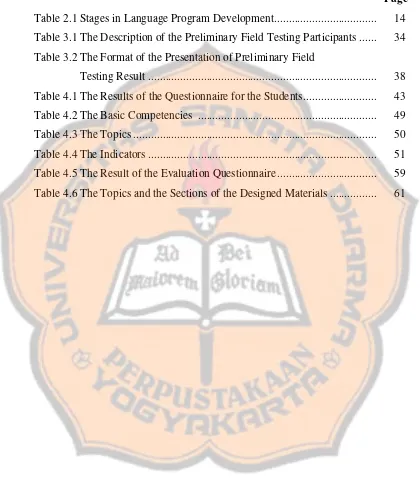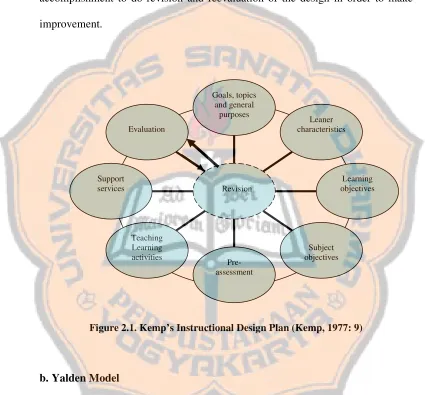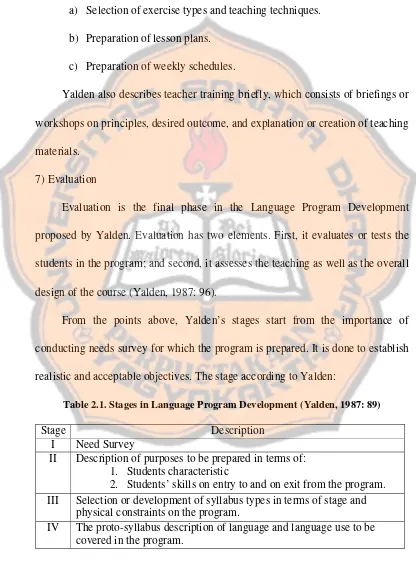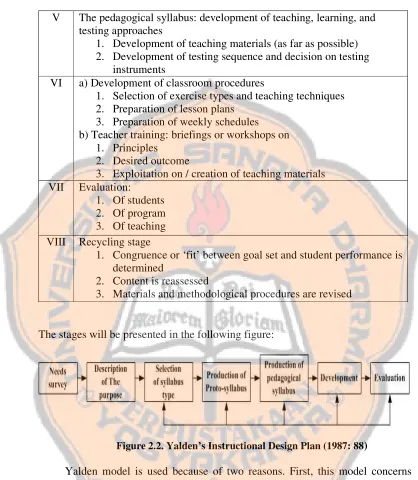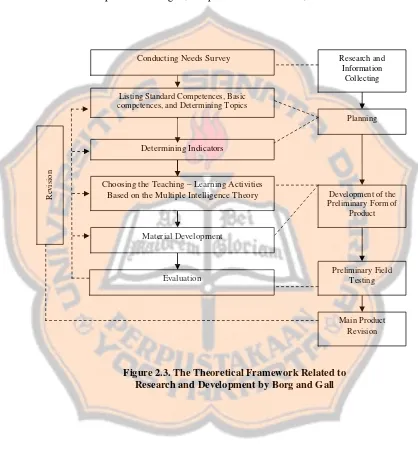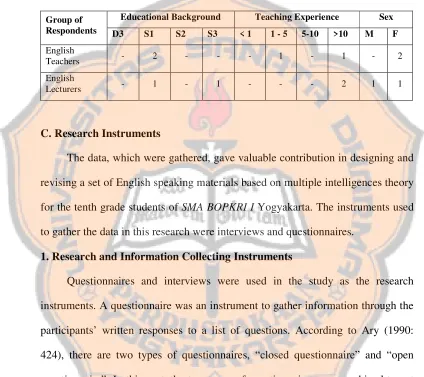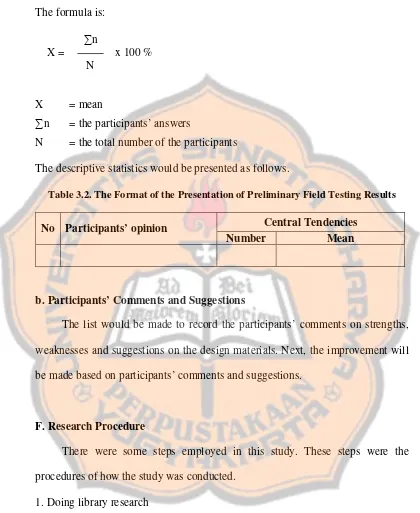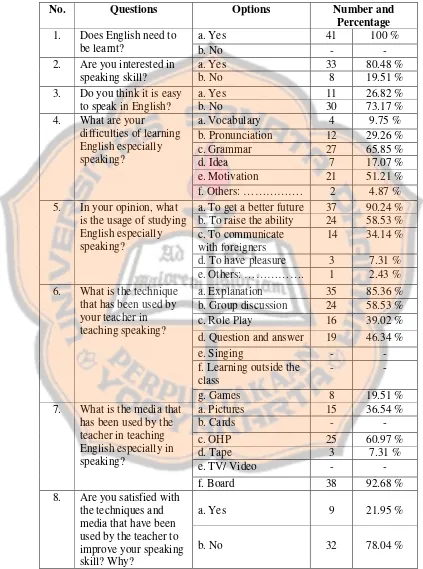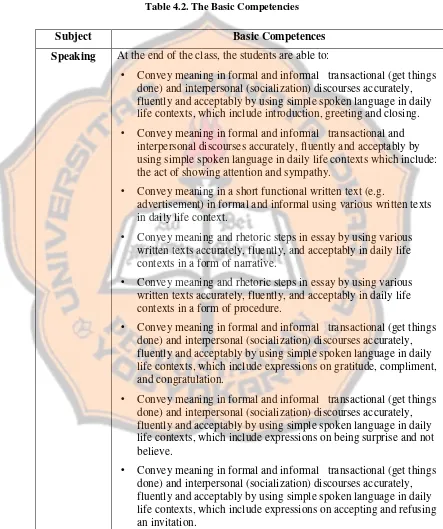SPEAKING MATERIALS BASED ON THE MULTIPLE INTELLIGENCE THEORY
FOR THE TENTH GRADE STUDENTS OF SMA BOPKRI I YOGYAKARTA
A THESIS
Presented as Partial Fulfillment of the Requirements to Obtain the Sarjana PendidikanDegree
in English Language Education
By
Regina Arum Utami Student Number: 021214105
ENGLISH LANGUAGE EDUCATION STUDY PROGRAM DEPARTMENT OF LANGUAGE AND ARTS EDUCATION
FACULTY OF TEACHERS TRAINING AND EDUCATION SANATA DHARMA UNIVERSITY
iv
vi
ACKNOWLEDGEMENTS
I give my deepest thanks to my major sponsor C. Tutyandari, S.Pd., M.Pd.
and to my co. sponsor, Drs. Concilianus Laos Mbato, M.A., for helping me to
make the thesis possible.
I wish to thank Ms. Yuseva for supports and guidance. My appreciation also
goes to Andre, Kilia and Bili for being my living companions, to my dear friends
Wulan, Anggi, Ikas, Reni, Grace, Arai, Cicil, Lita, Udjo, O’ok, Dedi, Miko, Icha
and Dias; for the eternal support, love, and never ending friendship. I thank Elvin
and Erlisya, for giving me an opportunity to engage in pleasurable teaching, and I
thank my mom and dad.
I give my gratitude for the students and teachers of SMA Bopkri I
Yogyakarta, for sharing good times. “The brightest of blessing and love.”
viii
TABLE OF CONTENTS
Page
TITLE PAGE ... i
APPROVAL PAGE ... ii
DEDICATION PAGE ... iv
STATEMENT OF WORK’S ORIGINALITY ... v
ACKNOWLEDGEMENTS ... vi
TABLE OF CONTENTS ... viii
LIST OF FIGURES ... xii
LIST OF TABLES... xiii
ABSTRACT ... xiv
ABSTRAK... xv
CHAPTER I: INTRODUCTION... 1
A. Research Background ... 1
B. Problem Formulation ... 4
C. Problem Limitation ... 4
D. Research Objectives... 5
E. Research Benefits ... 5
1. For students... 5
2. For English teachers... 5
3. For other researchers ... 6
F. Definition of Terms ... 6
1. Design ... 6
2. Instructional Materials... 6
3. Speaking ... 7
4. Intelligence ... 7
5. Senior High School Students ... 8
CHAPTER II: REVIEWOF RELATED LITERATURE... 9
A. Theoretical Description... 9
ix
a. Kemp Model... 9
b. Yalden Model ... 12
2. The Tenth Grade Students of Senior High School’s Characteristics .. 16
a. Social Development... 17
b. Emotional Development ... 17
c. Cognitive Development ... 17
3. Speaking Skill Theory ... 17
a. Nature of Speaking ... 17
b. The Process of Speaking ... 18
c. Teaching Speaking... 19
4. The Multiple Intelligence Theory ... 20
a. The Eight Intelligences ... 21
b. Applying Multiple Intelligences Theory in the Classroom ... 23
1) The Multiple Intelligences Activities Used in the Classroom ... 23
2) Deliberately Plan Lessons ... 24
c. The Description of Multiple Intelligences Theory in the Speaking Class ... 25
d. The Teachers Roles in Teaching Speaking Based on Multiple Intelligences Theory ... 25
e. The Students Roles in Teaching Speaking Based on Multiple Intelligences Theory ... 26
5. Educational Research and Development ... 26
B. Theoretical Framework ... 28
CHAPTER III: METHODOLOGY ... 31
A. Research Method ... 31
B. Research Participants ... 33
1. Research and Information Collecting Participants... 33
2. Preliminary Field Testing Participants ... 33
C. Research Instruments ... 34
1. Research and Information Collecting Instruments... 34
x
D. Data Gathering Technique ... 36
1. Research and Information Collecting ... 36
2. Preliminary Field Testing ... 36
E. Data Analysis Technique ... 37
1. Research and Information Collecting ... 37
2. Preliminary Field Testing ... 37
a. Descriptive Statistics of Participants’ Opinions on the Designed Materials ... 37
b. Participants Comments and Suggestions ... 38
F. Research Procedure... 38
CHAPTER IV: RESEARCH FINDINGS AND DISCUSSION ... 40
A. Material Development ... 40
1. Conducting Needs Survey ... 40
a. The Results of the Interview for the English Teacher of SMA BOPKRI I Yogyakarta ... 41
b. The Results of the Questionnaires for the Tenth Grade Students of SMA BOPKRI I Yogyakarta ... 42
2. Listing Standard Competences, Basic Competences, and Determining Topics... 46
3. Determining Indicators... 46
4. Choosing the Teaching and Learning Activities Based on Multiple Intelligence Theory ... 47
5. Material Development... 47
6. Evaluation ... 47
7. Revision... 48
B. The Designed Materials... 48
1. Listing Standard Competences, Basic Competences, and Determining Topics... 48
2. Determining Indicators... 50
xi
4. Material Development ... 57
5. Evaluation ... 58
a. The Description of Participants... 58
b. Data Presentation ... 58
c. Participants’ Comments and Suggestions on the Materials Design... 60
6. Revision ... 60
a. Response to the Participants’ Evaluation ... 60
b. The Presentation of the Designed Materials ... 61
CHAPTER V: CONCLUSIONS AND SUGGESTIONS ... 63
A. Conclusions ... 63
B. Suggestions... 64
REFERENCES ... 66
APPENDICES ... 69
Appendix A. Letter of Permission ... 70
Appendix B. General Description ... 74
Appendix C. Research and Information Collecting... 79
Appendix D. Preliminary Field Testing Questionnaires... 83
Appendix E. The Syllabus... 86
Appendix F. The Lesson Plan ... 94
Appendix G. The Teaching Learning Activities and the Intelligences Being Developed ... 123
xii
LIST OF FIGURES
Page Figure 2.1 Kemp’s Instructional Design Plan ... 12
Figure 2.2 Yalden’s Instructional Design Plan ... 15
Figure 2.3 The Theoretical Framework Related to Research and
xiii
LIST OF TABLES
Page
Table 2.1 Stages in Language Program Development... 14
Table 3.1 The Description of the Preliminary Field Testing Participants ... 34
Table 3.2 The Format of the Presentation of Preliminary Field Testing Result ... 38
Table 4.1 The Results of the Questionnaire for the Students... 43
Table 4.2 The Basic Competencies ... 49
Table 4.3 The Topics ... 50
Table 4.4 The Indicators ... 51
Table 4.5 The Result of the Evaluation Questionnaire... 59
xiv ABSTRACT
Utami, Regina A. 2008. Speaking Materials Based on the Multiple Intelligence Theory for the Tenth Grade Students of SMA BOPKRI I Yogyakarta. Yogyakarta: English Language Education Study Program, Sanata Dharma University.
This study aims to design speaking materials based on the Multiple Intelligence (MI) theory for the tenth grade students of SMA BOPKRI I
Yogyakarta. The areas of intelligences to be elaborated in this study are Verbal-Linguistic, Mathematical-Logical, Musical, Visual-Spatial, Bodily-Kinesthetic, Interpersonal, Intrapersonal, and Naturalist Intelligences.
This study had two research questions: (1) how are speaking materials based on the Multiple Intelligence theory for the tenth grade students of SMA BOPKRI I
Yogyakarta designed? And (2) what do speaking materials based on the Multiple Intelligence theory for the tenth grade students of SMA BOPKRI I Yogyakarta designed look like? The five steps of R & D cycle were employedto answer two questions above. The five steps were: (1) Research and Information Collecting, (2) Planning, (3) Development of the Preliminary Form of Product, (4) Preliminary Field Testing, and (5) Main Product Revision.
Kemp and Yalden instructional design models provided steps to answer the first question. There were seven steps employed based on Kemp’s and Yalden’s instructional design models: (1) Conducting Needs Survey, (2) Determining Competency Standards, Basic Competences, and Topic, (3) Determining Indicators, (4) Choosing Teaching-Learning Activities, (5) Material Development, (6) Evaluation, and (7) Revision. Based on the evaluation by the English teachers of SMA BOPKRI I Yogyakarta and English Education lecturers of Sanata Dharma
University; the mean was 4.0 up to 4.5 on a scale of 1-5. It is concluded that the designed materials are good and acceptable. In order to answer the second question, the final version of the designed materials was presented after conducting some revisions based on the feedbacks, comments, and suggestions from the preliminary field testing participants. The final version of the designed materials consists of nine units and each unit consists of intelligences that will be developed. The nine units, namely: (1) Getting to Know You, (2) What’s the Matter? (3) My Story, (4) Living Well, (5) It’s Simple like ABC, (6) Thank you…, (7) Oh, My God! (8) A Party?, and (9) Discovery Channel. The detailed presentation of the designed materials can be found in the appendix H.
xv ABSTRAK
Utami, Regina A. 2008. Speaking Materials Based on the Multiple Intelligence Theory for the Tenth Grade Students of SMA BOPKRI I Yogyakarta. Yogyakarta: Program Studi Pendidikan Bahasa Inggris, Universitas Sanata Dharma.
Penelitian ini bertujuan untuk merancang materi pembelajaran speaking
berdasarkan teori kecerdasan ganda bagi siswa kelas sepuluh SMA BOPKRI I Yogyakarta. Aspek-aspek yang akan dibahas di dalam penalitian ini adalah: kecerdasan verbal-linguistik, matematis-logis, musik, ruang-visual, kinestetik-badani, interpersonal, intrapersonal, dan kecerdasan alam.
Penelitian ini mengemukakan dua pertanyaan: (1) Bagaimana merancang materi speaking berdasarkan teori kecerdasan ganda bagi kelas sepuluh SMA BOPKRI I Yogyakarta? (2) Bagaimanakah bentuk rancangan materi speaking
berdasarkan teori kecerdasan ganda bagi kelas sepuluh SMA BOPKRI I Yogyakarta? 5 langkah metode siklus R&D dipergunakan untuk menjawab dua pertanyaan diatas. 5 langkah tersebut adalah: (1) pengumpulan informasi dan hasil2 penelitian, (2) perencanaan, (3) pengembangan bentuk awal materi, (4) pengujian awal di lapangan, dan (5) perbaikan materi utama.
Model pembelajaran Kemp dan Yalden menyediakan langkah-langkah untuk menjawab pertanyaan pertama. Ada 7 langkah yg digunakan berdasarkan model pembelajaran Kemp and Yalden: (1) mengadakan survey kebutuhan, (2) menentukan standar kompetensi, kompetensi dasar, dan topik, (3) merumuskan indikator, (4) menentukan kegiatan pembelajaran, (5) pengambangan materi, (6) evaluasi, dan (7) perbaikan. Berdasarkan hasil evaluasi yang diperoleh dari guru-guru bahasa Inggris SMA BOPKRI I Yogyakarta dan dosen-dosed Pendidikan Bahasa Inggris Universitas Sanata Dharma; rata-rata yang diperole adalah 4.0 sampai 4.5 dari skala 1-5. Maka, dapat disimpulkan bahwa materi yang di rancang ini baik dan dapat diterima. Untuk menjawab pertanyaan ke dua; versi akhir dari materi yang dirancang, diperbaiki berdasarkan masukan, komentar dan saran dari responden. Versi akhir materi yang dirancang terdiri atas sembilan unit dan setiap unit membahas beberapa kecerdasan yang akan diatih dan diajarkan. Sembilan unit itu adalah: (1) Getting to Know You, (2) What’s the Matter? (3) My Story, (4)
Living Well, (5) It’s Simple like ABC, (6) Thank you…, (7) Oh, My God! (8) A Party? dan (9) Discovery Channel. Materi secara detail dapat dilihat pada apendiks H.
CHAPTER I INTRODUCTION
This chapter presents the introduction of the study. It is divided into six
parts: research background, problem formulation that formulates the questions
which will be answered in this study, problem limitation that will identify the
scope and the focus of the study, research objectives that present the expected
results, research benefits that will elaborate what the benefits are, and definition of
terms that defines significant words or phrases specially used in the study to
clarify concepts and avoid misinterpretation.
A. Research Background
Language is a means of communication. Through language one builds
relationships with others. The ability to function in a language is generally
characterized in terms of being able to speak that language (Nunan, 1999: 225).
According to Bloomfield (1993: 21), “Until the days of printing, literacy was
confined to a very few people. All languages were spoken through nearly all of
their history by people who did not read or write. By far the greater numbers of
known speech, communities speak their language; none has ever been discovered
that writes its language without speaking it.” Everybody speaks a language.
Wherever we find a man, we find him speaking. One of the most important
languages that must be considered is English. Mastering English means having
ability to speak that language. Since English is an international language, it is
The study focuses on designing speaking materials based on the Multiple
Intelligences (MI) theory for the tenth grade students of Senior High School.
There are two considerations underlying the study taken. First, speaking is
considered important to be used as a means of communication in English. Second,
the tenth grade of Senior High School students is expected to be able to master
speaking skill well based on Multiple Intelligences theory.
The tenth grade of Senior High School students are chosen since at their age
(16 years old), the students are trying to know themselves deeply such as finding
themselves as a complete and independent person through knowing their
personalities and strengths. According to Craig (1979: 434), age 16 is
adolescence’s best time in life ‘for action, both as the natural and formal frame of
the body and mind,’ because it is a period of strength and vigor, or purer
conscience that will direct them to their places in adult society. In other words,
age 16 is the best age to give adolescences a chance to explore their multiple
intelligences. The students have the opportunity to explore their potentials to be
better people. By introducing them to the designed materials based on multiple
intelligences theory, the students can actively involve in classroom and both to
learn recognizing and developing multiple intelligences in them.
The study uses the theory of multiple intelligences. The theory was
proposed by Howard Gardner (1983). Gardner claimed that all human beings
possess multiple intelligences, which can be nurtured and strengthened through
training and practice. According to Gardner in Intelligence Reframed: Multiple
intelligences, such as Verbal-Linguistic Intelligence, Mathematical-Logical
Intelligence, Musical Intelligence, Visual-Spatial Intelligence, Bodily-Kinesthetic
Intelligence, Interpersonal Intelligence, Intrapersonal Intelligence, and Naturalist
Intelligence in varying amounts; (2) each person has a different intellectual
composition; (3) education can be improved by addressing the multiple
intelligences for students; (4) these intelligences are located in different areas of
the brain and can either work independently or together; (5) these intelligences
may define the human species. In short, each individual manifests varying level of
these different intelligences, and thus each person has a unique ‘cognitive profile’.
The theory of multiple intelligences proposes a major transformation in
education world (Campbell, 1996: xviii). It provides eight different potential
pathways in learning English and suggests several ways in which the material can
be presented to facilitate effective learning. It challenges teachers to present their
lessons in wide variety of ways using music, cooperative learning, art activities,
role-play, multimedia, field trips, inner reflection, and so forth. The various
activities offered by multiple intelligences theory such as learning through music,
pictures, charts, group work will be helpful in practicing and developing the
students’ speaking skill. Furthermore, multiple intelligences theory not only gives
opportunities for the students to have a new way to know and find their potentials,
but also gives teachers an awareness that stimulates them to find more ways of
helping students in their classes. Teachers do not have to teach a material in all
eight ways, just see what the possibilities are, then decide which particular
In other words, teachers should realize that different students have different
degrees of intelligences. Some students are smart in dealing with mathematics and
logic; some are genius in music. Some are good at literature and so forth. In
everyday English class, sometimes both teachers and students do not realize their
obvious intelligences. The students cannot use their intelligences in the class
activities. Hence, in the study, the eight intelligences above are considered as
important aspects in designing a set of speaking instructional materials.
To sum up, the theory of multiple intelligences intends to create a different
classroom activity in speaking so that the students will find learning English is
more interesting and challenging. With an understanding of Gardner’s theory of
multiple intelligences, teachers can better understand their students. They can
allow students to explore and learn English in many ways, and help students to
direct their own learning English through speaking.
B. Problem Formulation
The study aims to answer two main problems. The two problems are stated
as follows.
1. How are speaking materials based on multiple intelligence theory for the tenth
grade students of SMA BOPKRI I Yogyakarta designed?
2. What do speaking materials based on multiple intelligence theory for the tenth
grade students of SMA BOPKRI I Yogyakarta designed look like?
C. Problem Limitation
The study has three problem limitations. First, the designed material is
students of SMA BOPKRI I Yogyakarta (adolescence about 16 years old). Second,
due to the limitation of time in teaching speaking, all of the eight intelligences
cannot be applied at once in one topic. At least, in order to familiarize the teachers
with the theory of multiple intelligences, the materials will be combined with as
much the intelligences that are relevant with the topic discussed possible. Third,
the materials were structured only on multiple intelligences theory.
D. Research Objectives
The study aims to answer the problems formulated in the problem
formulation as follows.
1. To find out how speaking materials based on multiple intelligence theory for
the tenth grade of SMA BOPKRI I Yogyakarta are designed.
2. To present the speaking materials based on multiple intelligence theory for the
tenth grade of SMA BOPKRI I Yogyakarta.
E. Research Benefits
The study is conducted to achieve several benefits.
1. For students
Hopefully the design will help students to experience multiple intelligences
activities that can stimulate their intelligences in learning English through
speaking.
2. For English teachers
The instructional materials can be a starting point to help English teachers to
teach and learn to develop the students’ intelligences in teaching-learning
3. For other researchers
The study will hopefully encourage them to make an evaluation and
revision. Expectantly, they can produce a better one in the future.
F. Definition of Terms
There are several terms need to be defined in order to avoid
misinterpretation and misunderstanding.
1. Design
The term ‘design’ is defined as creating a new set of materials that fit the
learning objectives and specifics subject area of particular students (Hutchinson
and Waters, 1994: 106). According to Houle (1978: 230), design is a developed
plan to guide educational activity in a situation. The plan refers to the design
itself, which will be used in the class. The term design in the study refers to create
a new set of speaking instructional materials based on the theory of multiple
intelligences.
2. Instructional Materials
Dick and Reiser suggest that instructional materials are the materials
planned or designed by the teacher for the teaching instructions (1983:3).
Savignon defined instructional materials as a resource in pursuing language
activities (1983:24). In the study, the instructional materials is defined as a set of
materials consisting of activities and exercises planned and arranged as a resource
to pursue a language activity in teaching English for the tenth grade students of
3. Speaking
Speaking ability is the ability to practice language as a system to convey
meaning (Gastain, 1988: 292). In the speaking process, the speaker produces the
massage and the hearer receives it. Thus, speaking is a part of reciprocal exchange
in which the reception and production play apart (Widdowson, 1978: 57). In the
study, speaking is defined as activities to utter words with voice to express
opinions, feelings, and ideas.
4. Intelligence
Gardner as cited by Campbell defined that intelligence as the ability to solve
problems that one encounters in real life, the ability to generate new problems,
and the ability to make something or offer a service that is valued within one’s
culture (1996: xv). From the definition, intelligence is not marked from the test
that we have before. Intelligence is wider than that. It is more complex than it
seems. Intelligence is about how a person tries to solve his own problem in his
life, how intelligence helps people to question new problems in order to achieve
something more than they have right now. Additionally, Wechsler, the developer
of the Intelligence Scales for children, adolescents, and adults, prefers to define
intelligence as the capability or global capacity of the individuals to act
purposefully, to think rationally, and to deal effectively with environment
(Wechsler, 2000: 1). In the study, intelligence then, is the power for students to
achieve their success in learning English as a second language through speaking
5. Senior High School Students
In Indonesia the term SMA, which stands for Sekolah Menengah Atas refers
to Senior High School. It is a level of education that should be completed in three
years. Students start the level at ages 15-16. They are considered as a young adult
who wants to have more opportunities for social contacts their age (Clark, 1991:
CHAPTER II
REVIEW OF RELATED LITERATURE
This chapter discusses the theories that are used to answer the research
problems. There are two main sections in the chapter; theoretical description and
theoretical framework.
A. Theoretical Description
Theoretical description is concerned with discussion on two instructional
material design models applied in the study and some significant theories on
which the study is based.
1. Instructional Design Models
In the study, Kemp and Yalden models are used for the basic guidelines in
designing a set of speaking instructional materials based on multiple intelligences
theory.
a. Kemp Model
Kemp says that instructional design plan is designed to supply the answer of
three questions, which are considered to be the essence of instructional technology
(1997: 8). The three are as follows.
1) What must be learnt? (Objectives)
2) What procedures and resources will work best to reach the desired learning
levels? (Activities and resources)
To answer those three questions, Kemp (1997 8-9) proposes program
development, which consists of eight interdependence parts in it. The eight parts
of Kemp’s program development are as follows.
1) Goals, Topic, and General Purposes
Goals are the bases of all educational programs, which can be derived from
three sources — society, students, and subject areas (Kemp, 1997: 14). Topics,
which become the scope of the source or program, are usually sequenced
according to a logical organization, from simple or concrete levels to complex and
more abstract levels (Kemp, 1997: 15). Planning for instruction often starts with
teacher – oriented statements of general purposes for topics. In shorts, general
purposes are what students generally are expected to learn as a result of
instruction.
2) Leaner Characteristics
In order to assure a student’s success in his educational program, the teacher
should recognize and respect the student as an individual learner. Kemp states that
to serve both group and individual means that teacher must obtain information
about students’ capabilities, needs, and interests (1997: 18-19). These should
affect the emphases in instructional planning, including the selection topics and
the level at which topics are introduced, the choice and sequencing of objectives,
the depth of treatment, and the variety of learning activities.
3) Learning Objectives
Teacher is concerned with learning as the outcome of instruction. Learning
he must attaint, the ideas and skills that will be included in the upcoming
instruction, and the types of behaviors that will be expected during the evaluation.
Thus, all objectives must be stated in terms of activities that will best promote
learning.
4) Subject Content
Subject content must closely relate to the objectives and the student’s need.
Subject content comprises the selection and organization of the specific
knowledge (facts and information), skills (step-by-step procedures, conditions,
and requirements), and behavioral factors of any topic (Kemp, 1997: 44).
5) Pre-Assessment
Pre-assessment is carried out in order to plan learning activities for which
students is prepared and at the same time to ensure that the student does not waste
his time on things he already knows.
There are two kinds of test in this step. Prerequisite testing that is done to
determine whether student has the appropriate background preparation for the
topic and pre-testing, which is done to determine which of the objectives the
students may already have achieved.
6) Teaching-Leaning Activities and Recourses
Teacher must determine the most efficient and effective methods in carrying
out the teaching-learning activities and then select materials to provide learning
experiences that will utilize the content associated with each objective.
7) Support Services
Funds, facilities, equipments, and personnel must be considered to carry out
the instructional plan (Kemp, 1997: 84). If certain support is not available, it can
8) Evaluation
Evaluation is the pay-off step in the instructional design plan, for both the
students and the teacher (Kemp, 1997: 91). The teacher evaluates the students’
accomplishment to do revision and reevaluation of the design in order to make
improvement.
Figure 2.1. Kemp’s Instructional Design Plan (Kemp, 1977: 9)
b. Yalden Model
Janice Yalden’s Language Program Development is divided into seven
stages. The explanation of seven stages is as follows.
1) The Need Survey
The course designer carries out a needs survey to obtain as much
information as possible in any given situation about the students and about his Goals, topics
and general purposes
Leaner characteristics
Learning objectives
Subject objectives Pre-
assessment Teaching
Learning activities Support
services
Evaluation
purposes in acquiring the target language. The reason for this entire information
gathering is to understand as much about the student as possible prior to the
beginning of the program, in order to establish realistic and acceptable objectives
(Yalden, 1987: 101).
2) The Description of Purpose
The purpose of the language program is as the foundation for the major
decision facing the language course designer when he arrives at the next stage that
is the selection or development of syllabus type.
3) The Selection or Development of Syllabus Type
There is no single model of syllabus design, which is universally agreed
upon. The course designer can combine various types of syllabuses and put
various focuses on oral or written language as required.
4) The Production of a Proto-Syllabus
In this stage, the syllabus designer produces a proto-syllabus or the
description of language and language use to be elaborated in the program. There
are a large number of elements to be considered such as general notions and
specific topics, communicative functions, discourse and rhetorical skills, variety
of language, role-sets, and communicative events, as well as grammar, and lexis
(Yalden, 1987: 138).
5) The Production of a Pedagogical Syllabus
The pedagogical syllabus provides a repertoire of words and phrases, chosen
as exponents of functions and suitable to the topics identified as important to the
student (Yalden, 1987: 144). 6) The Development and Implementation of
Yalden (1987: 89) gives a brief description on the development and
implementation of classroom procedures, which comprise of:
a) Selection of exercise types and teaching techniques.
b) Preparation of lesson plans.
c) Preparation of weekly schedules.
Yalden also describes teacher training briefly, which consists of briefings or
workshops on principles, desired outcome, and explanation or creation of teaching
materials.
7) Evaluation
Evaluation is the final phase in the Language Program Development
proposed by Yalden. Evaluation has two elements. First, it evaluates or tests the
students in the program; and second, it assesses the teaching as well as the overall
design of the course (Yalden, 1987: 96).
From the points above, Yalden’s stages start from the importance of
conducting needs survey for which the program is prepared. It is done to establish
realistic and acceptable objectives. The stage according to Yalden:
Table 2.1. Stages in Language Program Development (Yalden, 1987: 89)
Stage Description
I Need Survey
II Description of purposes to be prepared in terms of: 1. Students characteristic
2. Students’ skills on entry to and on exit from the program. III Selection or development of syllabus types in terms of stage and
physical constraints on the program.
V The pedagogical syllabus: development of teaching, learning, and testing approaches
1. Development of teaching materials (as far as possible) 2. Development of testing sequence and decision on testing
instruments
VI a) Development of classroom procedures
1. Selection of exercise types and teaching techniques 2. Preparation of lesson plans
3. Preparation of weekly schedules b) Teacher training: briefings or workshops on
1. Principles 2. Desired outcome
3. Exploitation on / creation of teaching materials VII Evaluation:
1. Of students 2. Of program 3. Of teaching VIII Recycling stage
1. Congruence or ‘fit’ between goal set and student performance is determined
2. Content is reassessed
3. Materials and methodological procedures are revised
The stages will be presented in the following figure:
Figure 2.2. Yalden’s Instructional Design Plan (1987: 88)
Yalden model is used because of two reasons. First, this model concerns
with the importance of need survey in designing instructional materials. Second,
this model is a learner-centered, because it concerns with the students
characteristics and their skills. By knowing students’ characteristics and skills, it
would be less difficult in designing the materials for developing the students’
In the study, Kemp and Yalden models are combined in order to be the basic
guidelines in designing the materials. The models provide steps that are needed in
order to answer the first question mentioned in the problem formulation. The
combination of these two models will be explained further in the theoretical
framework in designing integrated instructional materials based on multiple
intelligences theory for tenth grade of Senior High School students.
2. The Tenth Grade Students of Senior High School’s Characteristics
It is very important to find out about the students’ characteristics. Since
knowing students’ characteristics will be very helpful to make the materials
become more effective. The tenth grade students of Senior High School are
considered as adolescents aged around 15 – 18 years old. Adolescence can be
categorized as a stage of search for one’s self-marked by intimate peer affiliation
and clique formation, by discovery of high values and ideals, by development of
personality and identity formation, and by attainment of adult status with its
challenging tasks and responsibilities (Pikunas, 1976:240).
According to Konopka as cited by Pikunas, there are three classifications of
adolescence: early adolescence (12-15 years old), middle adolescence (15-18),
and late adolescence (19-22). Refer to this theory, the tenth grade of senior high
school students are middle adolescence. There are several developments that
happened during the middle adolescence stage (Pikunas, 1976: 259): social
a. Social development
There is improvement in self-definition, self-reliance, so that
companionships become less passionate than they were in early adolescence.
b. Emotional development
It is said that middle adolescence is the period of heightened oscillation
between polarized moods. New sexual feelings, self-doubts, self-consciousness,
questions about future, parental pressures, and concerns about being accepted by
peers make life very difficult.
c. Cognitive development
Adolescence is now capable of processing formal proportional reasoning,
logical theorizing, and questioning about causes. In this stage, special abilities and
gifts are vividly shown. There will also refinement and polishing of many
cognitive functions.
One fact about the students is that the students are unique beings; there are
no students that are exactly identical even the twin students. They are different in
some aspects: personality, skills, abilities, talents, interests, and intelligences.
More serious handling is needed in this phase.
3. Speaking Skill Theory
There are three parts in discussing the theory of speaking: nature of
speaking, the process of speaking, and teaching speaking.
a. Nature of Speaking
Most language teaching concerns with developing skills in short interaction
in which the learners are required to make one or two utterances at time. Speaking
is simply productive when it is conceived of terms of usage. According to
that makes use of auditory media. The skill of speaking involves active and
productive participation.
Nunan said that mastering the art of speaking is the single most important
aspect of learning a second or foreign language, and success is measured in terms
of the ability to carry out conversation in the language in term of vice versa
(Nunan, 1991: 39). Thus, to speak not only means the learner are able to use
language in communication but also means the learner are able to produce
understandable and communicative language.
b. The Process of Speaking
According to Rivers (1968: 158), learning a second language is more than
learning a description of a language itself, there is also process of speaking and
listening. They are complementary needed in the activity of oral skills. Banathy
(1976: 15) states that the objective of speaking a foreign language at the end of the
course is the students will be able to speak the target language in communicative
events. Therefore, they will be trained in such a way, so they will be able to
produce communication by using the language. There are two types of activities in
the process of speaking according to Clark and Clark (1977: 260): planning and
execution.
Planning activities consists of major plans. They are discourse plans in
which the speakers decide what kind of discourse they participate in so that they
can convey the right message; sentence plans in which the speaker decide which
sentences they will produce in certain discourse; constituents plan in which the
and put them in the right order); and articulator program in which the speakers
save words chosen in their memory.
Next, in planning the activities the speakers have to execute the activities by
performing the contents of their speech with audible sounds in the right sequence
and timing.
In learning a language, especially the speaking skill, the teachers must try to
speak in the target language in order to encourage the students to master the
speaking skill automatically.
c. Teaching Speaking
Paulstron and Bruder (1976: 56) state that teaching speaking cannot be
separated from the ideas of teaching communicative ability. Communicative
ability is the production of speakers’ ability to communicate the target language.
Students improve their speech when teachers provide insights on how to organize
their ideas for presentation. The most important thing for the teacher is to give the
students more opportunities to practice their speaking skill by providing them
with more communicative activities, which put them into the real practice of
communication. Teachers can enable the students to present ideas to individual,
peers, peer groups and entire class of students. They can learn to speak on a
subject of their own choosing or on teachers’ assigned topics. When given the
opportunities, both teachers and students can provide suggestions for students’
performances. In constructively criticizing others, students can learn to apply
criteria for good speech and employ skilful social skills. In doing so, they can
4. The Multiple Intelligence Theory
Learning nowadays has a purpose to build a human being, which is good in
all aspects of life. Consequently, to improve the quality of education, the teaching
learning should not be emphasized in cognitive domain only, but also to all
aspects of humanity such as morale, attitudes, arts, sports, etc. Learning in school
should motivate students to be active and happy learners. Happy students learn
more readily than they who are not. Additionally, to make the learning successful,
teachers should acknowledge that their students are unique learners who posses
different style in learning. Since all students do not learn in the same way, they
cannot be assessed in the same way. Knowing about students’ learning will allow
the teacher to properly assess the students’ progress (Lazear, 1992: 17).
Considering the students’ different learning style, the teachers should find an
alternative in teaching to give more contribution toward learning.
Gardner’s Theory of Multiple Intelligences provides a theoretical foundation
for recognizing the different cognitive strengths and talents of students. Learners
are viewed as a unique learner who possesses individual learning styles, and
intelligences. The theory of Multiple Intelligences was introduced by Howard
Gardner in 1983. He suggested that all individuals have personal intelligence
profiles that consist of combination of seven different intelligence types. And in
Intelligence Reframed: Multiple Intelligences for the 21st Century (1999), he
added one intelligence type. The all eight intelligences are verbal-linguistic,
mathematical-logical, visual-spatial, bodily-kinesthetic, musical, interpersonal,
Gardner published Frames of Mind, multiple intelligence theory has been used by
educators as a tool for understanding and effectively meeting the learning needs of
their students (Armstrong, 1994: xii). Gardner’s multiple intelligence theory has
been applied to foreign language teaching and learning by many scholars
(Berman, 1998: 2).
a. The Eight Intelligences
Howard Garner claims that all human being have multiple intelligences.
These multiple intelligences can be nurtured and strengthened. He believes each
individual has eight intelligences (1999: 41-47). The eight intelligences are as
follows.
1) Verbal-Linguistic Intelligence: the intelligence to use words in effective way,
in oral form as in written. It includes ability to understanding order and meaning
words, convincing someone, explaining, teaching, learning, memory and recall,
and meta-linguistic analysis.
2) Logical-Mathematical Intelligence: the intelligence to use numbers in an
effective way, and to transform with dexterity. Logical-mathematical intelligence
is activated in situations requiring problem solving or meeting a new challenge as
well as situations requiring pattern discernment and recognition. Capacities
involved abstract pattern recognition, inductive reasoning, deductive reasoning,
discerning relationships and connections, performing complex calculations, and
scientific reasoning.
3) Visual-Spatial Intelligence: the intelligence relies on the sense of sight and
images. The intelligence is triggered by presenting the mind with colorful design,
pattern, shapes, pictures, and engaging in active imagination through such things
as visualization guided imagery. Capacities involved active imagination, forming
mental images, image manipulation, graphic representation, recognizing
relationships of objects in space, and accurate perception from different angles.
4) Bodily-Kinesthetic Intelligence: the intelligence to control one’s body
movement and to handle object skillfully. Bodily-Kinesthetic Intelligence
possesses specific physical abilities as the coordination, the balance, the dexterity,
the force, the flexibility, and the speed. Capacities involved control of movement,
expanding awareness through the body, the mind and body connection, and
mimetic abilities.
5) Musical Intelligence: the intelligence to produce sounds based on the
recognition of tonal patterns, including various environmental sounds, and on
sensitivity to rhythm and beats. Capacities involved appreciation for the music
structure, scheme in the mind for hearing music, sensitivity to sounds,
recognition, creation and production of melody or rhythm, and sensing
characteristic qualities of tone.
6) Interpersonal Intelligence: the intelligence operates primarily through
person-to-person, relationships and communication. It is activated by person-to-person
encounters in which such things as effective communication, working together
with others for common goal. Capacities involved effective verbal/non verbal
communication, working cooperatively in a group, ability to discern other’s
underlying intentions and behavior, creating and maintaining synergy, and
7) Intrapersonal Intelligence: the intelligence relates to self-awareness of with
inner feelings, values, belief and thinking processes. Capacities involved
concentration of mind, mindfulness, awareness and expression of different
feelings.
8) Naturalist Intelligence: capacity to distinguish, to classify and to use the
numerous species of the flora and fauna in natural environments. It includes
abilities to understand behaviors, necessities and characteristics of the animals and
plants; also, to experience and to question about the environment.
b. Applying Multiple Intelligence Theory in the Classroom
Gardner’s theory of multiple intelligences has several implications for
teachers in term of the activities in the classroom and material presentation. The
theory states that all eight intelligences are needed in education. Teachers,
therefore, should think of all intelligences as equally important. The activities
used in the classroom must imply multiple intelligence theory and teacher should
recognize and teach to a broader range of talents and skills. Another implication is
that teachers should structure the presentation of materials that engages most or all
of the intelligences. The presentation not only excites students about learning, but
also it allows a teacher to use the material in variety of ways of teaching.
1) The Multiple Intelligence Activities Used in the Classroom
Since the students have different degrees of intelligences, teachers should
create activities that bring along the eight intelligences, not only facilitate
language acquisition but also help the students realize their potential ability. To
help teachers in conducting multiple intelligences theory in the class (Campbell,
1996: 1-196). The activities are as follows.
a) Verbal-Linguistic Intelligence: lecturing, drilling, discussing, note taking,
reading aloud, summarizing, playing vocabulary and grammar games, giving oral
presentation.
b) Logical-Mathematical Intelligence: classifying things, problem solving, critical
thinking, playing puzzles and computer games, understanding, creating graphs,
and making prediction.
c) Visual-Spatial Intelligence: mind mapping, storyboarding, reading maps and
diagrams, watching films.
d) Bodily-Kinesthetic intelligence: role playing, dancing, doing physical games,
acting out words, doing body language and gestures, moving around.
e) Music Intelligence: singing songs, using music, composing songs or rhymes,
playing music.
f) Interpersonal Intelligence: leading and organizing, cooperating, sharing and
comparing ideas, group working, gaming, debating and discussing, interviewing.
g) Intrapersonal Intelligence: working individual, doing self-paced instruction,
planning, listing favorite things.
h) Naturalist Intelligence: categorizing, investigating, linking, being outside, and
analyzing similarities and differences.
Teachers should try to accustom themselves using multiple intelligences
theory in the classroom by choosing activities that present particular intelligences.
2) Deliberately Plan Lessons
The activities that have been chosen should be categorized according to
and interpersonal intelligence will be regularly activated. The teacher needs to
deliberately plan lessons so that the different intelligences are represented in
teaching and learning process (Larsen, 2000: 184). To check whether or not the
teachers have focused on the eight different types of multiple intelligences,
Christison (1998: 30) added that teachers should use charts to show eight
intelligences that have been successfully learned.
c. The Description of Multiple Intelligence Theory in the Speaking Class In creating an interesting speaking class, the students should experience
speaking in a variety of speaking activities. By experiencing different activities in
speaking, the students will perceive speaking as a relevant act occurring between
themselves, others and society. In short, through the variety of speaking activities,
the students will be more aware and thoughtful about their purpose in speaking.
d. The Teacher Roles in Teaching Speaking Based on Multiple Intelligence Theory
The teachers should have an understanding that students are unique and they
learn with different learning styles, and it is important for teachers to understand
students’ difficulty in learning speaking as well. As the year progress, the role of
teacher changed becoming less directive, and more facilitative. According to
Campbell et all (1996: xxi), it is essential for the teachers to demonstrate pleasure
in speaking process and give students efforts to improve their speaking skill
ability. Teachers should help the students to reduce their fears by maintaining a
friendly atmosphere in the class and providing opportunities for students to
e. The Students Roles in Teaching Speaking Based on Multiple Intelligence Theory
Multiple intelligence approach is student-centered (Gardner, 1993: 78). By
applying multiple intelligence theory in speaking class, students are given a
chance to explore and learn English in many ways, and they have opportunities to
direct their own learning.
According to Richards and Rodgers (2001: 118), to be a better second
language learner, a leaner should be:
1) A goal-directed learner. Students can benefit from learning by setting
themselves presentation goals and assessing their own progress.
2) A happy Learner. Through the various activities offered by Multiple
Intelligence Theory, the students will experience a different atmosphere of
speaking class.
5. Educational Research and Development
Borg and Gall (1983: 771) suggest a strategy to develop and educational
products effectively. This strategy is called research and development (R&D). It
consists of a cycle in which a version of the product is developed, field-tested, and
revised on the basis of field-test data. The steps of this strategy are usually
referred to as the R&D cycle. The major steps in the R &D cycle are as follows.
a Research and information collecting- Includes review of literature,
classroom observation, and preparation of report of state of the art.
b Planning- Includes defining skills, stating objectives determining
c Develop preliminary form of product- Includes of instructional
materials, handbooks, and evaluation devices.
d Preliminary field testing- Conducted in from 1 to 3 schools using 6 to
12 subjects. Interview, observational, and questionnaire data collected
and analyzed.
e Main product revision- Revision of product as suggested by the
preliminary field-test results.
f Main field testing- Conducted in 5 to 10 schools with 30 to 100
subjects. Quantitative data on subjects’ precourse and postcourse
performances are collected. Results are evaluated with respect to
course objectives and are compared with control group data, when
appropriate.
g Operational product revision- Revision of product as suggested by
main field-test results.
h Operational field testing- Conducted in 10 to 30 schools involving 40
to 200 subjects. Interview, observational, and questionnaire data
collected and analyzed.
i Final product revision- Revision of product as suggested by
operational field-test results.
j Dissemination and implementation- Report on product at professional
meeting and in journals. Work with publisher who assumes
commercial distribution. Monitor distribution to provide quality
Educational research and development (R&D) is a process used to develop
and validate educational products (Borg & Gall, 1983:772). This study is also
intended to develop and validate educational products for the tenth grade of
Senior High School Students. For thus, this study belongs to educational research
and development.
B. Theoretical Framework
There are seven steps to take in designing the instructional materials based
on the Multiple Intelligences theory. The steps are the combination of Kemp and
Yalden models. The steps are as follows.
1. Conducting Needs Survey
This step is adapted from Yalden instructional design model. In the study,
the designing materials will be based on multiple intelligences theory for the tenth
grade of Senior High School students and conducting needs survey is the starting
point in designing the materials. It is used to learn about the students’ needs. In
doing so, questionnaires were distributed to the students of the tenth grade of
Senior High School and an informal interview was conducted for the tenth grade
English teacher of Senior High School.
2. Listing Standard Competences, Basic Competences, and Determining Topics
This step is adapted from Kemp model. It was used to determine the basic
competences of the materials design based on the students’ need. The topics, then,
were chosen based on the necessity to achieve the goals. 2006 curriculum was
3. Determining Indicators
This step is adapted from Kemp instructional design model. Since multiple
intelligences theory is used in the design materials, hence the materials should
contain the practice of developing multiple intelligences in order to achieve the
learning objectives of 2006 curriculum.
4. Choosing Teaching-Learning Activities Based on the Multiple Intelligence Theory
The materials consist of the activities, which are based on the multiple
intelligence theory. The step also shows the ways to develop the students’
multiple intelligences through various activities according to multiple intelligence
theory (Kemp model). 5. Material Development
Material development consists of a communicative task based on multiple
intelligences theory in which students use it to master English through their
speaking ability (Kemp and Yalden models).
6. Evaluation
In Evaluation, the designed materials based on multiple intelligences theory
are being analyzed by English lecturers and teachers. From the result of the
evaluation, there will be feedbacks to show whether or not the materials are
appropriate and can be applied for the tenth grade students of Senior High School.
If the materials are far from the achievement standards, so some changes should
be done in order to improve the result of the achievement of the students. There is
no such thing as perfect materials. They can always be improved (Kemp and
7. Revision
Revision was done after obtaining the feedback from evaluation. This step
was done to improve the design (Kemp and Yalden models).
R
ev
is
io
n
Choosing the Teaching – Learning Activities Based on the Multiple Intelligence Theory
Material Development
Evaluation
Figure 2.3. The Theoretical Framework Related to Research and Development by Borg and Gall
Determining Indicators Listing Standard Competences, Basic competences, and Determining Topics
Conducting Needs Survey Research and
Information Collecting
Planning
Development of the Preliminary Form of
Product
Preliminary Field Testing
CHAPTER III METHODOLOGY
This chapter is divided into six main parts: research method, research
participants, research instruments, data gathering technique, data analysis
technique, and research procedure.
A. Research Method
Here, the research method used in the study was Research and Development
(R & D), in order to develop and validate educational products (Borg and Gall
1983: 772). The processes in R & D were usually referred as the R & D cycle, which consisted of studying research findings pertinent to the product to be
developed, developing the product based on findings, field testing in the setting
where it would be used eventually, and revising it to correct the deficiencies found
in the field testing stage. Borg and Gall stated that there are ten major steps used
in the Research and Development method (R&D) cycle to develop the products
(1983: 775). They are research and information collecting, planning, development
of preliminary form of product, product evaluation, main product revision, main
field testing, operational product revision, operational field testing, final product
revision, dissemination and implementation.
In order to answer the two major problems mentioned above, step one until
step five would be employed. The steps are explained as follows:
1. Researches and Information Collecting
Research and information collecting included rationale of this study, review
(Borg and Gall, 1983: 775). In this step, describing the designed material as
specific as possible became the important thing. Thus, questionnaires would be
distributed to the tenth grade students of Senior High School, and an informal
interview was conducted for the teachers. Moreover, the curriculum was checked
in order to obtain the data. The data were used as a source to obtain the students’
needs and information and opinion from the teacher about the topics which were
suitable for the tenth grade students of Senior High School.
2. Planning
In this study, planning included defining skills, stating objectives and
determining sequence. Those aspects would be applied to develop a suitable
syllabus and lesson plans to teach speaking for the tenth grade students of Senior
high School. The statement of the specific objectives to be achieved by the
designed material became the important aspect in this step (Borg & Gall 1983:
779). Objective offered the basis of developing an instructional program since the
program could be field tested and revised until it met its objectives.
3. Development of the Preliminary Form of Product
Development of the preliminary form of product included preparation of
instructional materials, handbooks, and evaluation devices. In this step, designer
had to organize the designed materials so as to permit obtaining as much feedback
as possible. Then, the feedback was used to evaluate and revise the material
design.
4. Preliminary Field Testing
Preliminary field testing was applied to obtain the evaluation for the
instructional materials. In this study, questionnaires were used to gain the
material so that the designed material would work properly. The evaluation was
obtained from the tenth grade teachers of Senior High School and English
lecturers of Sanata Dharma University.
5. Main Product Revision
After obtaining the evaluation from the product evaluation, next, the result
or suggestions would be applied to revise the materials as recommended by the
teachers and lecturers. Thus, the data collected from the product evaluation would
be used as the basis to obtain the final designed material.
B. Research Participants
In conducting the survey study, the information was obtained from the
participants in research and information collecting to obtain the students’ need and
from preliminary field testing to improve the designed materials.
1. Research and Information Collecting Participants
The first year students of SMA BOPKRI I Yogyakarta were needed since they were the participants for the teacher’s techniques and to find out their
interests and needs.
The tenth grade teachers of SMA BOPKRI I Yogyakarta were also involved as the interviewees to collect information. It was done to find out the students’
need from teachers’ view. Moreover, they were closely related to the teaching
learning process. Thus, their comments provided the information for designing the
materials.
2. Preliminary Field Testing Participants
There were two groups of participants in this step. First were the tenth grade
Education Study Program of Sanata Dharma University. Their comments gained evaluation and feedback on the designed materials.
Table 3.1. The Description of Preliminary Field Testing Participants
Educational Background Teaching Experience Sex
Group of
Respondents D3 S1 S2 S3 < 1 1 - 5 5-10 >10 M F
English
Teachers - 2 - - - 1 - 1 - 2
English
Lecturers - 1 - 1 - - - 2 1 1
C. Research Instruments
The data, which were gathered, gave valuable contribution in designing and
revising a set of English speaking materials based on multiple intelligences theory
for the tenth grade students of SMA BOPKRI I Yogyakarta. The instruments used to gather the data in this research were interviews and questionnaires.
1. Research and Information Collecting Instruments
Questionnaires and interviews were used in the study as the research
instruments. A questionnaire was an instrument to gather information through the
participants’ written responses to a list of questions. According to Ary (1990:
424), there are two types of questionnaires, “closed questionnaire” and “open
questionnaire”. In this part, the two types of questionnaire were combined to get
the appropriate answer. The questionnaire was called semi-open questionnaire
where the checklist questions type were used for the tenth grade students of SMA BOPKRI I Yogyakarta. The checklist question type defines as questions with number of possible answers (Ary, Jacobs, and Razeviech, 2002: 424-425). The
An interview was conducted with the English teachers of SMA BOPKRI I
Yogyakarta. Ary et al (1979: 418) stated that interview is an instrument, which
allows flexibility since the interviewer is able to observe the subject as well as the
situation and paraphrase the question when needed. There are two kinds of
interview questions, open-ended questions and closed questions. The participants’
answers in the open-ended question were freer than in the closed question because
the answers are already provided. Interview was needed in order to explore more
the answers of the participants in this case were the English teacher; and to
develop materials appropriate to students’ ability and need. The interviewees were
the English teachers who were considered to know the ability of the students and
what the students needed so the material would be more effective and efficient.
Moreover, interview was used to find the teachers’ experience and opinions in
teaching speaking including their techniques, materials, strategies, topic choices
and teaching media. Information from the teacher was useful to develop the
material since the teacher had an experience in teaching speaking.
2. Preliminary Field Testing Instruments
The questionnaire was used in the preliminary field testing. Both closed
questionnaire and open questionnaires were given to the English language
teachers of SMA BOPKRI I Yogyakarta and lecturers of English Education Study
Program of Sanata Dharma University. The questionnaires were aimed to gain
participants’ opinions and comments on the designed material that could obtain
feedback and evaluation to design suitable speaking materials based on multiple
D. Data Gathering Technique
1. Researches and Information Collecting
The data was gathered through distributing questionnaires to the students
and interviewing the English teacher. The purpose of distributing the
questionnaires was to figure on the learners’ needs. The informal interview was
also held to obtain information from the teachers of SMA BOPKRI I Yogyakarta.
The questionnaires were distributed on February 12, 2008 as well as the informal
interview. The purpose of the informal interview was to find out the teachers’
experiences and opinions in teaching English speaking including their techniques,
materials, strategies, topic choices and teaching media.
Library study was done as well to find some sources that could be used to
develop the designed materials. This activity was done by finding some books
related to this study.
2. Preliminary Field Testing
In order to obtain final version of the materials, questionnaires on the
developed materials were distributed to English teachers of SMA BOPKRI I
Yogyakarta and English lecturers of Sanata Dharma University. The
questionnaire for product evaluation was distributed on August 12 – 26, 2008. The
questionnaire was intended to figure out the participants’ opinion and comments
on the designed materials. Besides, it was expected to provide evaluation and
feedback to improve the designed material so that the best final version of the
